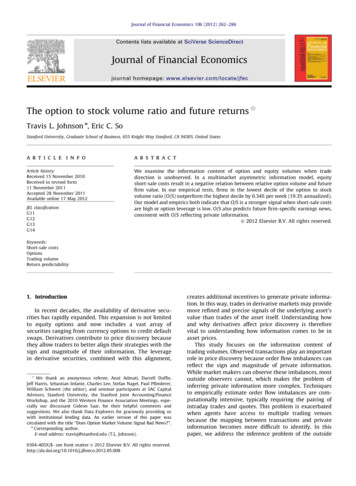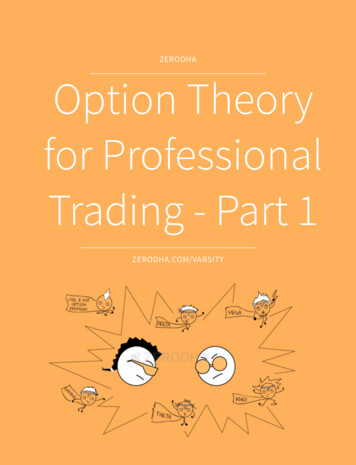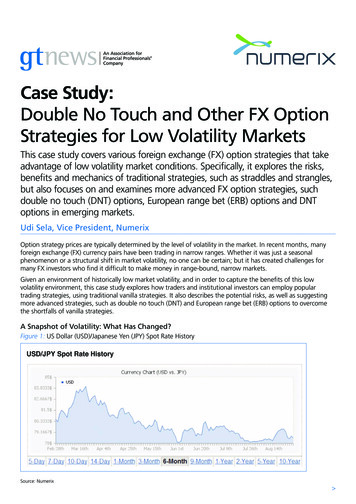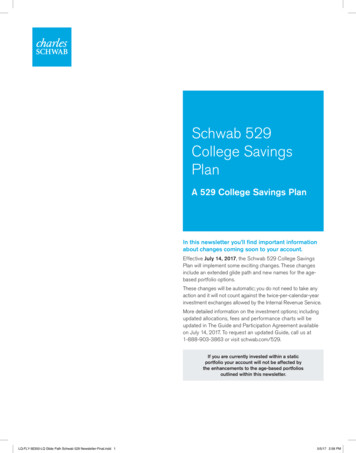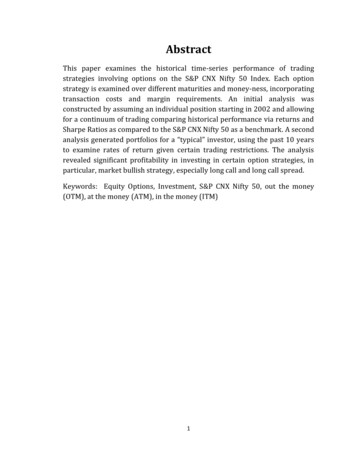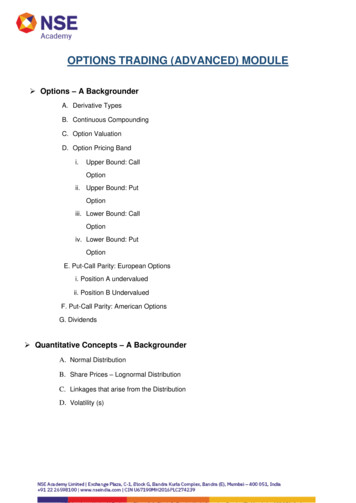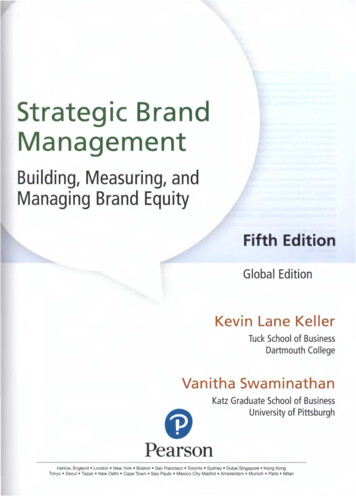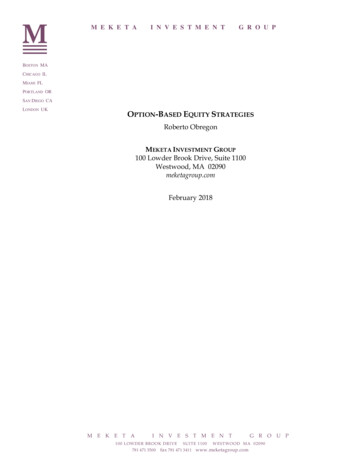
Transcription
M E K E T AI N V E S T M E N TG R O U PBOSTON MACHICAGO ILMIAMI FLPORTLAND ORSAN DIEGO CALONDON UKOPTION-BASED EQUITY STRATEGIESRoberto ObregonMEKETA INVESTMENT GROUP100 Lowder Brook Drive, Suite 1100Westwood, MA 02090meketagroup.comFebruary 2018M E K E T AI N V E S T M E N T100 LOWD ER BROOK DRIVE781 471 3500SUITE 1100G R O U PWESTWOOD MA 02090fax 781 471 3411 www.meketagroup.com
MEKETA INVESTMENT GROUPOPTION-BASED EQUITY STRATEGIESABSTRACTOptions are derivatives contracts that provide investors the flexibility of constructing expected payoffsfor their investment strategies. Option-based equity strategies incorporate the use of options with longpositions in equities to achieve objectives such as drawdown protection and higher income. While therange of strategies available is wide, most strategies can be classified as insurance buying (net longoptions/volatility) or insurance selling (net short options/volatility).The existence of the Volatility Risk Premium, a market anomaly that causes put options to be overpricedrelative to what an efficient pricing model expects, has led to an empirical outperformance of insuranceselling strategies relative to insurance buying strategies.This paper explores whether, and to what extent, option-based equity strategies should be consideredwithin the long-only equity investing toolkit, given that equity risk is still the main driver of returnsfor most of these strategies. It is important to note that while option-based strategies seek to designfavorable payoffs, all such strategies involve trade-offs between expected payoffs and cost.BACKGROUNDOptions are derivatives1 contracts that give the holder the right, but not the obligation, to buyor sell an asset at a given point in time and at a pre-determined price. In exchange for thisbenefit, option buyers pay a premium (the option price) to option sellers.There are two types of options: calls and puts. The former gives the purchaser the right to buyan asset, and the latter gives the right to sell it. To explain how option contracts behave relativeto their underlying assets, it is worth introducing the following terminology:Table 1. Options TerminologyTerminologyOption PremiumPrice a buyer of an option pays to the sellerExpiration DateDate at which the option expiresStrike PricePrice at which the option buyer can buy (sell) the underlying assetMoneynessRefers to the relationship between the strike price of the option and thecurrent price of the underlying asset.At the money (ATM)Strike price equals underlying’s priceIn the money (ITM)Strike price is lower (higher) than the underlying’s price for a call (put)Out of the money (OTM)Strike price is higher (lower) than the underlying’s price for a call (put)Option Style1MeaningRefers to the ability of exercising the optionEuropeanMay only be exercised at the expiration dateAmericanCan be exercised at any time before expirationAs a refresher, a derivative is any financial instrument that derives its value from another asset. Options, futures,and forwards and swaps are the most popular derivatives instruments.1
MEKETA INVESTMENT GROUPOPTION-BASED EQUITY STRATEGIESFor investors, the utility of options comes mainly from their flexibility. Option strategies areall about designing a desired payoff structure and evaluating the cost tradeoff of achievingsuch payoff.As we can observe, buying an option gives its holder much flexibility. With a call option, itallows a holder to participate in the underlying asset’s upside but not its downside. Similarly,the holder of a put can actually profit from the underlying’s downside without participatingin its upside. While the payoff profile is certainly asymmetric, option sellers can also createprofitable strategies by collecting the option premiums, if the asymmetric scenario is notrealized. In the example above, a call seller will profit if at expiration date, the price of theunderlying asset is below 50.2Chart 2. Payoff Structure for Call and Put Options3Asset60Long Call2020Payoff40Payoff400Asset60Call Premium0Put Premium-20-20Strike PriceStrike Price-40-40-60-60010203040506070Price of Underlying AssetAsset6080900100Short CallStrike Price3040506070Price of Underlying AssetAsset8090100Short PutCall Premium0Strike Price20PayoffPayoff204020Put Premium0-20-20-40-40-60-60031060402Long Put10203040506070Price of Underlying Asset8090100010203040506070Price of Underlying Asset8090100On the other hand, a put seller will profit if at expiration date, the price of the underlying asset is at or above 50.These options positions are commonly known as “naked,” because they don’t include a position in theunderlying asset, as opposed to “covered” positions, that do include a position in the underlying asset.2
MEKETA INVESTMENT GROUPOPTION-BASED EQUITY STRATEGIESIn general, buying an option is akin to buying insurance on the performance of the underlyingasset. Focusing on the payoff of put options, the option buyer pays an insurance policypremium (option price) that grants her protection in the event that the underlying assetdeclines in value more than its deductible (option strike price). Following this reasoning, theoption’s expiration date would represent the length of the insurance policy. It is clear to seethat selling a put option (i.e., the opposite transaction) is like selling insurance. The optionseller collects the premium and, in exchange, is liable to cover any losses in the event theunderlying asset declines in value more than its deductible (option strike price) during thelength of the policy period. This is a very important concept because the most popularoption-based equity strategies can be categorized as either buying or selling insurance on theperformance of the underlying assets.While payoffs at expiration are certain,4 there are several variables that influence theprice/value of option contracts while they are current and that are, in general, all related totheir underlying assets. These relationships are named for Greek letters; they describe thesensitivity of an option’s price to the given underlying parameter and are generally referredto as the option’s “Greeks.” The primary Greeks are summarized in the table below.Table 3. Option Greeks5Greek LetterSensitivity of Option’s Price to:Long CallShort CallLong PutShort PutDeltaUnderlying Asset’s g Asset’s sage of Time /Time DecayNegativePositiveNegativePositiveRhoInterest RatesPositiveNegativeNegativePositiveDelta: This is the most widely used Greek for options. It measures an option’s price sensitivityto movements in the price of its underlying asset. Without getting into the specifics aboutoption pricing, it is worth mentioning that the price of an option is determined by the value ofa portfolio of assets that replicates the payoff of the option. Taking a stock option for example,this portfolio consists of the underlying stock and a zero coupon risk-free bond.Call options are replicated with a long position in a stock and short position in a risk-free bond.Therefore, a long position in a call option has a positive beta to its underlying asset; and a shortposition in a call option has a negative beta to its underlying asset.6Replicating Portfolios𝐶𝑎𝑙𝑙 Δ 𝑆𝑡𝑜𝑐𝑘 𝑅𝑖𝑠𝑘 𝐹𝑟𝑒𝑒 𝐵𝑜𝑛𝑑𝑃𝑢𝑡 Δ 𝑆𝑡𝑜𝑐𝑘 𝑅𝑖𝑠𝑘 𝐹𝑟𝑒𝑒 𝐵𝑜𝑛𝑑Δ Delta456Excluding counterparty or default risk.For the purpose of this paper, we discuss only first-order sensitivities. Second order options sensitivities, suchas Gamma, are widely followed by option traders, yet less relevant to this analysis.On the other hand, put options are replicated with a short position in stock and a long position in a risk-freebond. This means that a long position in a put option has a negative beta to its underlying asset; and a shortposition in a put option has a positive beta to its underlying asset.3
MEKETA INVESTMENT GROUPOPTION-BASED EQUITY STRATEGIESThis is an important concept because equity option strategies usually either take advantage ofthis implicit beta exposure to capture equity-like returns or try to hedge it away to reduceequity exposure. Not surprisingly, hedging away the underlying equity exposure of an optionis called “delta-hedging”.7 It is worth noting that the Delta of an option is not static; itconsistently varies with the price of its underlying asset. In all cases, the closer an option, bothcalls and puts, is to being at the money, the higher its delta (in absolute value), meaning thevalue of the option is more greatly determined by the underlying asset than by a risk-freebond. Strategies that hedge delta exposure need to take this behavior into account to ensureeffective results.Vega: holding all else equal, long positions in options (calls and puts) benefit from increasedvolatility in the underlying asset. The more volatile an underlying asset is, the greater theprobability that its option will end up at or in the money during its life, making the derivativemore valuable. Options are priced more in terms of the volatility of its underlying asset thanthe price of the asset itself.8However, there is a slight, but very important distinction: options are priced in terms of impliedvolatility, or the market’s expectations of volatility, for the underlying asset. Yet optionpayoffs are determined by the realized volatility of the underlying asset. Many option-basedstrategies, which we describe in greater detail later, take advantage of this relationship.Theta: This variable refers to how the value of an option is affected by the passage of time.Unlike equities, which in general are perpetual assets, option contracts expire, and given thatwe know their payoff at expiration (dependent on the underlying asset of course), its valueneeds to converge to this payoff by expiration. In general, the passage of time is negative forlong options positions and positive for short option positions. As an “out of the money” optionapproaches expiration, the probability that it becomes “in the money,” and thus valuable atexpiration, diminishes.Because option buyers pay a premium for the right to access their desired payoffs, the longeran option has before it expires, the more opportunity the contract has to realize the payoff.The losses generated by purchasing options that expire worthless is generally referred to as“Theta bleed.”78Delta-Gamma hedging is a more sophisticated way to hedge the underlying asset exposure of an option;however, it is beyond the breadth of this paper.The price of the underlying is also an input to pricing an option yet options traders think about buying and sellingoptions in terms of buying and selling volatility, hence the concepts of being long or short volatility when buyingor selling options.4
MEKETA INVESTMENT GROUPOPTION-BASED EQUITY STRATEGIESTYPES OF STRATEGIESThere is a wide range of equity option-based strategies available. Given the asymmetries thatexist with options payoffs, there are an infinite number of strategies that can be constructedby combining long and short positions in calls and puts. However, all strategies can be dividedinto two main groups: those that are long volatility (i.e., buy insurance), and those that areshort volatility (i.e., sell insurance). Furthermore, the differences between those that have thesame objective, either buying or selling insurance, generally come from the tradeoffs investorsmake between cost and payoff.Below we expand on the most popular equity option-based strategies, paying special interestto strategies that include or complement a long position in equities. Note that all payoff chartsshown assume fully collateralized option positions9 and are for illustrative purposes only.Buying InsuranceProtective Put: Long Stock Long PutChart 4. Protective Put Strategy PayoffStrategy60AssetLong ATM Put40Payoff200-20Strike Price-40-600102030405060Price of Underlying Asset708090100This is the most direct way to buy insurance on the performance of a long stock position.Buying a put option of the underlying asset allows the option holder to avoid losses if its longstock position decreases in value below the option’s strike price. The chart above shows thepayoff for buying at the money puts; as is the case with this strategy and all subsequent onesthat will be reviewed, the strategy payoff is obtained by vertically adding the correspondingcomponents, in this case long the asset and long the put. It is important to point out the kinks9Fully collateralized option positions assume no leverage (implicit or explicit). This means that the completenotional exposure of the options is “collateralized” by holding cash.5
MEKETA INVESTMENT GROUPOPTION-BASED EQUITY STRATEGIESon the lines always refer to the effect of adding an option strategy, as their payoffs are nonlinear, unlike those of traditional assets.Similar to an insurance policy, an investor has the flexibility to select an out of the moneyoption (lower strike price) to reduce premium payments, but at the expense of increasing thedeductible (i.e., its exposure to the underlying’s drawdown).Below we observe how the selection of strike price affects the expected payoffs of theprotective put strategy. Assuming a current asset price of 50, a 10% out of the money (OTM)Put requires lower premium output, which helps outperform an ATM Put in scenarios ofmoderate or no drawdowns (ending price of underlying greater or equal than 48), but thiscomes at the expense of underperforming in all other drawdown scenarios.Chart 5. Put Strike Price as DeductibleAssetAsset ATM PutAsset 10% OTM Put1510Payoff50-5ATM Put Stike Price10% OTM Put Stike Price-10-1530354045505560Price of Underlying AssetIn general, the cost of implementing this strategy is not trivial, and perhaps even prohibitive.A protective put strategy requires rolling expiring put option positions by periodically10paying the option premium, detracting from the performance of the long stock position inmost market environments.Collar: Long Stock Long Put Short CallTo mitigate the cost of outright buying insurance (i.e., buying puts), investors are sometimeswilling to give up some of the upside of their long option positions to generate additionalincome to cover the cost of buying a put option. A collar on a long stock position combinesthe long put option with a short call option, which generates premium income in exchange oflimiting equity upside.10Periodicity of option rolling varies by strategy, it can range from daily or weekly and all the way up to multipleyears, yet rolling option positions every month is the most common case.6
MEKETA INVESTMENT GROUPOPTION-BASED EQUITY STRATEGIESChart 5. Collar Strategy PayoffStrategy60AssetLong ATM PutShort OTM CallShort OTM Call Strike Price40Payoff200-20Long ATM Put Strike Price-40-600102030405060708090100Price of Underlying AssetWhile this strategy partially mitigates the premium payment, it does so at the expense ofgiving up some of the equity upside. This may seem counterintuitive, as most institutionalinvestors hold equities for upside potential; yet some investors may be willing to give up partof this upside potential in exchange for additional income, especially if they believe that anequity rally is unlikely. It is worth noting that strike prices on the options can be selected suchthat the premium received for selling the call completely offsets the premium paid for buyingthe put. This version of the strategy is referred to as a “zero-cost collar.”1111Due to pricing dynamics discussed later in the paper (see Chart 20: Implied Volatility Skew), in order to establisha true zero cost collar, an investor is generally required to give up more upside than the relative downsideprotection received.7
MEKETA INVESTMENT GROUPOPTION-BASED EQUITY STRATEGIESPut Spread Collar: Long Stock Long Put Short Call Short PutThe final strategy we review looks to further mitigate the cost of paying for insurance byreintroducing some downside protection. In addition to the premium income from selling thecall, a put spread collar provides additional income by selling a put option that is further outof the money than the purchased put option.12 However, the tradeoff for adding this incomeis eliminating downside protection on losses greater than the short put’s strike price.Chart 6. Put Spread Collar Strategy PayoffStrategy60AssetShort OTM CallShort OTM PutShort OTM Call Strike Price40Short OTM Put Strike Price20PayoffLong ATM Put0-20Long ATM Put Strike Price-40-600102030405060Price of Underlying Asset708090100While the payoff structure may seem complicated, comparing it to the Collar, it simply adds ashort put option in order to generate more premium income. The net effect is that itparticipates in the upside of the underlying equity, to a point, while reducing losses.Performance Review:Table 7. Options Strategies Risk Table – Buying Insurance13Monthly Returns: January 1990 – August 2017S&P 500Protective PutCollarPut CollarSpreadAnnualized Return9.6%6.2%6.0%6.4%Standard Deviation15.8%12.4%10.9%11.8%Sharpe ta to S&P 5001.000.740.660.74Max Drawdown1213The combination of a long put with a short put farther out of the money is called a Put Spread.Protective Put, Collar, and Put Collar Spread strategies represented by CBOE S&P 500 5% Put Protectionindex, CBOE S&P 500 95-110 Collar Index and CBOE S&P 500 Zero-Cost Put Spread Collar Index respectively.Source: Bloomberg. More details in Appendix 1.8
MEKETA INVESTMENT GROUPOPTION-BASED EQUITY STRATEGIESFrom the table above, it is clear that option-based equity strategies that buy protection fordrawdowns have not been worth the effort historically, neither in absolute nor risk adjustedterms. All strategies underperformed broad equities by at least 320 bps annualized, while atthe same time offering inferior Sharpe Ratios. The better drawdown behavior they offer hasnot compensated investors enough to overcome the drag caused by paying option premiumsor selling equity upside, or both. As a silver lining, reduced kurtosis and negative skewnessfor the Protective Put and Collar strategies are a clear sign of defensive capabilities, as thesestrategies have exhibited negative tail events less frequently and in lower magnitude whencompared to the S&P 500.Chart 8. Options Strategies Rolling 36-Month Performance – Buying InsuranceMonthly Returns: January 1990 – August 201740%S&P500Protective PutCollarPut Spread Collar30%20%10%0%-10%-20%When considering rolling periods, we can observe that while option-based strategies ingeneral outperformed during down markets, they trailed equities by wide margins during bullmarkets, contributing to their overall underperformance. However, as a caveat, we should notdiscard that the considered period included at least three very strong bull markets for equities.9
MEKETA INVESTMENT GROUPOPTION-BASED EQUITY STRATEGIESChart 9. Options Strategies Rolling 36-Month Correlations to S&P 500 – Buying InsuranceMonthly Returns: January 1990 – August 2017Protective PutCollarPut Spread Collar1.000.950.900.850.800.750.700.650.60A rolling correlation analysis shows that, while correlations tend to be high during mostperiods, they considerably decline during periods of equity market stress, creating adiversification effect exactly when it is needed most.Chart 10. Options Strategies Drawdowns – Buying InsuranceMonthly Returns: January 1990 – August 2017S&P500Protective PutCollarPut Spread Collar0%-10%-20%-30%-40%-50%-60%When we reviewed the expected payoffs for each strategy, we saw that, with the exception ofthe put spread collar, they should not participate in these drawdowns at all, or perhaps at mostby the amount of the insurance premium paid. However, as shown in chart 10, each of the10
MEKETA INVESTMENT GROUPOPTION-BASED EQUITY STRATEGIESoption-based strategies suffered meaningful, though smaller, losses during drawdowns. Theprimary explanation for this disconnect can be seen in chart 11.Chart 11. S&P Drawdowns vs. Put Premium14Monthly Returns: January 2005 – August 2017Put Premium7%-10%6%5%-20%4%-30%3%-40%2%-50%1%-60%Put Premium (% of Index Price)S&P 500 DrawdownS&P500 014201520162017This is a clear example of how real market behavior does not quite fit with the assumptions offinancial models. The payoff charts we reviewed for the option strategies were based onbuying an option and holding it to expiration. Yet investors who want to implement thisstrategy over the long term must buy options that expire monthly15 on a continual basis.Therefore, at each expiry date they must buy an option to replace the expired one. Optionprices are not very stable, and unsurprisingly, the price of insurance increases dramaticallywhen it is most needed. This is a non-trivial effect for the strategies we reviewed because, tomaintain the desired exposures during equity market drawdowns, they needed to buyinsurance at very high prices, detracting heavily from performance and contributing to thedrawdown behaviors we saw above.1415Put premium estimated based on Black-Scholes-Merton option pricing model and 30-day ATM impliedvolatilities on S&P 500 options. Source: Bloomberg and MIG.Other lengths of expiration such as weekly, quarterly or annual can be used without changing the intuition.11
MEKETA INVESTMENT GROUPOPTION-BASED EQUITY STRATEGIESSelling InsurancePut Write: Cash Short ATM PutChart 12. Put Write PayoffStrategy6040AssetCashShort ATM PutShort ATM Put Strike PricePayoff200-20-40-60010203040506070Price of Underlying Asset8090100Put Write is the classic “short volatility” strategy and is the exact opposite of the protectiveput strategy. Here, an investor sells put options on the underlying asset and holds cash ascollateral. As with any insurance underwriter, the objective of this strategy is that over time,the income collected from selling the put options (more than) compensates for any potentiallosses in a drawdown event for the underlying asset. In general, this strategy shouldoutperform holding the underlying asset in down markets as the premium collected creates abuffer in performance. However, this comes at the expense of trailing the underlying asset inmost bull markets. As we see from the payoff diagram, the put write strategy may outperformits underlying asset in modest up markets as long as the premium collected on the option soldis higher than the gains on the underlying asset.As we saw when reviewing the Option’s Greeks, short put options have a positive exposureto the price movements of its underlying asset, or put another way, it has a positive beta. Thisbeta tends to hover between 0.5 and 1 for options that are close to at the money,16 so a put writestrategy can be thought of as a low beta equity strategy. It is important to reinforce the notionthat, while these strategies may have low positive beta, they are not necessarily “defensive,”as they offer a payoff structure of capped gains and unlimited losses.16The delta of short put option and also its beta to the underlying approaches 1 as its price moves closer to at themoney.12
MEKETA INVESTMENT GROUPOPTION-BASED EQUITY STRATEGIESBuy Write: Long Stock Short ATM CallChart 13. Buy Write PayoffStrategy60AssetShort ATM CallShort ATM Call Strike ce of Underlying AssetThe payoff of a Buy Write strategy is equivalent to that of a Put Write strategy,17 yet it isimplemented with a different pair of assets. In this case, we combine a long position in theunderlying asset with a short call option.Even though Buy Write and Put Write are equivalent in principle, the prior approach may bemore convenient to implement for investors who hold a long position in equities, as they canadd a short call option position as an overlay if they are comfortable with the tradeoff of givingup equity upside in exchange for a fixed amount of premium income. Investors may generallyaccept this tradeoff if they view an equity rally as unlikely in the near future. Furthermore,referring again to the analogy of the option strike price as an insurance policy deductible,selling a call option that is out of the money (i.e., has a higher strike price) generates lesspremium income but allows the option seller to participate in some of the upside of theunderlying. These reasons have made Buy Write a more common strategy to implement thanPut Write for institutional investors18.Finally, it is important to reinforce the notion that, while both Put Write and Buy Writestrategies may have low positive beta (since they are equivalent), they are not necessarilydefensive, as they offer a negative asymmetric payoff structure of capped gains and –almostunlimited losses19.171819This relationship holds thanks to a principle of option pricing known as “Put-Call Parity.”Furthermore, it can be argued that investors prefer a Buy Write strategy over a Put Write strategy (even thoughthey should be equivalent) to avoid the reputational risk of having to completely sell out of their equitiespositions.In reality, in absence of leverage, losses are limited by the amount of capital invested, in the –unlikely- scenariothat the equities position value goes to zero. See Appendix 3.13
MEKETA INVESTMENT GROUPOPTION-BASED EQUITY STRATEGIESPerformance:Table 14. Options Strategies Risk Table – Selling Insurance20Monthly Returns: January 1990 – August 2017S&P 500Put WriteBuy WriteAnnualized Return9.6%9.9%8.6%Standard Deviation15.8%10.6%11.0%0.420.650.52Sharpe RatioMax urtosis1.329.365.00Beta to S&P 5001.000.560.62Short volatility strategies exhibited superior risk-adjusted returns and lower drawdownsrelative to equities in the studied sample. Put Write even outperformed equities with muchlower volatility. However, consistent with their asymmetric payoff profiles, both Put Writeand Buy Write realized high negative skewness and kurtosis, a sign of a strategy that is proneto negative tail events more regularly and with higher magnitude than equities.Chart 15. Options Strategies Rolling 36-Month Performance – Selling InsuranceMonthly Returns: January 1990 – August 2017S&P500Put WriteBuy Write40%30%20%10%0%-10%-20%Rolling performance shows how both option strategies underperformed equities during bullmarkets (i.e., Tech Bubble in late ‘90s), yet they offered some drawdown protection duringtimes of market drawdowns. Interestingly, even though we should expect these strategies to20Put Write and Buy Write represented by CBOE S&P 500 Put Write Index and CBOE S&P 500 Buy Write Indexrespectively. Source: Bloomberg. More details in Appendix 1.14
MEKETA INVESTMENT GROUPOPTION-BASED EQUITY STRATEGIEShave equivalent payoffs, Put Write consistently outperformed Buy Write historically (more onthis later).Chart 16. Options Strategies Rolling 36-Month Correlations to S&P 500 – Selling InsuranceMonthly Returns: January 1990 – August 2017Put WriteBuy Write1.000.950.900.850.800.750.700.650.60While historical performance has been attractive, a rolling correlation analysis allows showsthat option strategies that sell insurance offer a payoff profile that increasingly correlates withits underlying asset when it experiences drawdowns. In other words, any diversificationbenefit that may appear to exist during calm times quickly disappears when it is most needed.Chart 17. Options Strategies Drawdowns – Selling InsuranceMonthly Returns: January 1990 – August 2017S&P500Put Write0%-10%-20%-30%-40%-50%-60%15Buy Write
MEKETA INVESTMENT GROUPOPTION-BASED EQUITY STRATEGIESDrawdowns for both option strategies are comparable in occurrence relative to equities, yet inlower magnitude given the premium income they capture regularly from selling options. Themarket dynamic that has historically made insurance (i.e., option prices) more expensive tobuy during times of market stress has likewise helped insurance-selling strategies recoverquicker than equities from drawdowns. This is contrary to what we saw with strategies thatbuy insurance, which suffered from buying more expensive premiums at these times.THE VOLATILITY RISK PREMIUMTo this point in our analysis, we have reviewed option strategies that, by design, either buy orsell insurance on the performance of an underlying asset. However, when reviewing historicalperformance we saw that the strategies that should theoretically protect from drawdownshave historically been more impacted by them than those that in theory are more exposed tosuch drawdowns. Additionally, over the studied period, selling insurance has been muchmore profitable from both an absolute and risk-adjusted return basis than buying insurance.Finally, when comparing the historical performance of two strategies (Put Write andBuy Write) that, by design, should be equivalent, we found that one, Put Write, has greatlyoutperformed the other, Buy Write.All of these apparent anomalies, inefficiencies, or disconnects between what option theorysuggests the payoffs should be and what they have effectively realized can be explained byone broad concept: the Volatility Risk Premium.During our review of the option’s Greeks,21 we saw that options are priced in terms of implied(forward looking) rather than realized (backward looking) volatilities. While most optionpricing models assume these two measures are equivalent,22 implied and realized volatilitiesrarely converge. In fact, the majority of time, implied volatility has been higher than realized.This phenomena is known as the Volatility Risk Premium.2122As a refresher, Vega is the term used to measure the sensitivity of an option’s price relative to changes in theunderlying asset’s –implied- volatility.An implicit assumption in most academic asset pricing theories is that parameters such as variance (or volatility)are
Option strategies are all about designing a desired payoff structure and evaluating the cost tradeoff of achieving such payoff. As we can observe, buying an option gives its holder much flexibility. With a call option, it allows a holder to participate in the u

